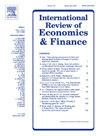应对关税冲击的货币政策:贷款便利作为补充工具
IF 5.6
2区 经济学
Q1 BUSINESS, FINANCE
引用次数: 0
摘要
在全球贸易紧张局势加剧和关税冲击一再出现的情况下,特别是在中美贸易冲突期间,中国的出口部门面临着越来越大的外部压力。作为回应,中国人民银行(PBoC)越来越依赖非常规货币政策来稳定经济。本文以中期贷款便利(MLF)为研究对象,评估其缓解外部关税冲击的有效性。本文利用2005年至2023年的月度数据和向量自回归(VAR)模型,分析了关税、净出口、货币政策工具和消费者价格之间的关系。结果表明,关税的增加显著减少了净出口,并造成了通货紧缩压力,暴露了中国对外部门对贸易政策不确定性的脆弱性。另一方面,MLF注入通过改善信贷渠道和增强企业抵御能力,对净出口产生积极影响,尽管有延迟。然而,MLF对通货膨胀的直接影响较弱,统计上不显著,表明对消费者价格的影响有限。这些发现凸显了多边货币基金业务在应对与贸易有关的冲击方面有针对性但受到限制的作用。因此,需要对传统的货币供给工具进行调整,以维持通胀目标。这些研究结果强调了有针对性的流动性支持在缓冲出口导向型经济体外部冲击方面的作用,并强调需要采取补充性的需求侧措施和体制改革,以提高政策有效性。本文章由计算机程序翻译,如有差异,请以英文原文为准。
Monetary policy responses to Tariff shocks: Lending facilities as a complementary tool
Amid rising global trade tensions and repeated tariff shocks, particularly during the U.S.–China trade conflict, China's export sector has faced growing external pressure. In response, the People's Bank of China (PBoC) has increasingly relied on unconventional monetary policies to stabilize the economy. This paper focuses on the Medium-term Lending Facility (MLF) to assess its effectiveness in mitigating external tariff shocks.、Using monthly data from 2005 to 2023 and a vector autoregression (VAR) model, this study analyzes the relationships among tariffs, net exports, monetary policy tools, and consumer prices. The results show that tariff increases significantly reduce net exports and create deflationary pressures, exposing the vulnerability of China's external sector to trade policy uncertainties. On the other hand, MLF injections positively impact net exports, though with a delay, by improving credit access and strengthening firm resilience. However, MLF's direct effect on inflation is weak and statistically insignificant, suggesting limited influence on consumer prices. These findings highlight the targeted yet constrained role of MLF operations in addressing trade-related shocks. Therefore, traditional money supply instruments need to be adjusted to maintain the inflation target. These findings highlight the role of targeted liquidity support in buffering external shocks for export-oriented economies and underscore the need for complementary demand-side measures and institutional reforms to enhance policy effectiveness.
求助全文
通过发布文献求助,成功后即可免费获取论文全文。
去求助
来源期刊
CiteScore
7.30
自引率
2.20%
发文量
253
期刊介绍:
The International Review of Economics & Finance (IREF) is a scholarly journal devoted to the publication of high quality theoretical and empirical articles in all areas of international economics, macroeconomics and financial economics. Contributions that facilitate the communications between the real and the financial sectors of the economy are of particular interest.

 求助内容:
求助内容: 应助结果提醒方式:
应助结果提醒方式:


